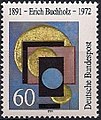Category:Constructivism on stamps
The art style on the Constructivism as philososophical basis of a movement in creative art and architecture begins undoubtably with the Russian artist Vladimir Tatlin (1885-1953) in 1913. Later it was one of the paragons of the "Bauhaus"-style in Germany or the style of the De Stijl-movement ("Plastical Art") in the Netherlands. The constructivism was not only limited on painting and architecture, rather it penetrate all areas of artifical creations, how for instance sculpture, graphic design, industrial design, theatre, film, dance, fashion and, to some extent, music.
The constructivism as theory was developed largely from debates at the "Institute of Artistic Culture" (INKhUK) in Moscow (Russia) in the time 1920 to 1922, for all after the deposing of its first chairman Wassily Kandinsky in 1921. The then "First Working Group of Constructivists" wanted develop a "Definition of Constructivism" as combination of the "...particular material properties of an object, his tectonic, and its spatial presence..." (own statement). Initially the Constructivists worked on three-dimensional constructions, for all the artists of the "OBMOKhU" ("Society of Young Artists"). This society organized exhihibitions in which mainly were showed these three dimensional compositions. Later this definition were extended also to designs for two-dimensional works such as books or posters. In this time appearanced artifical conceptions how "montage" and "factography".
The Russian constructivists worked mainly at public festivals and street designs for the then post-October revolution Bolshevik government. (artists how Kazimir Malevich and El-Lissitzky as most important representants of the theory of the "Russian Formalism at 'making strange'"). These theories were as initially tested in theater and circus (mainly the "biomechanics" of a Wsewolod Emiljewitsch Meyerhold, or the "scientific management"-theory of a Frederick Winslow Taylor). These ideas influenced also mainly German theater directors like Bertolt Brecht and Erwin Piscator, as well as the early Soviet cinema.
In the 1920 the Constructivists of the early Soviet Union organised themselves into the 'Left Front of the Arts', who produced the influential journal "LEF", (which had only two series, one 1923 to 1925 and an other 1927 - 1929 under the name "New LEF"). LEF was dedicated to maintaining the avant-garde against the critiques of the "Socialist Realism", and as the possibility of a capitalist restoration, whereas the journal remained particularly scathing evaluation of the 'NEPmen', the real capitalists of the then period. For LEF the new medium of cinema was more important than the easel painting and traditional narratives that elements of the Communist Party were trying to revive then. Important Constructivists were very involved with cinema, inclusively a poet how Mayakovsky acting in the film "The Young Lady" and the "Hooligan". Rodchenko's designs for the intertitles and animated sequences of Dziga Vertov's "Kino Eye" (1924), and Aleksandra Ekster designs for the sets and costumes of the science fiction film "Aelita" (1924) belongs also in this catgory as well as films how Vsevolod Pudovkin's "Storm over Asia" (1928) or Victor Turin's "Turksib" (1929). Filmmakers and LEF contributors how Dziga Vertov and Sergei Eisenstein as well as the female documentarist Esfir Shub also regarded their fast-cut, montage style of filmmaking as Constructivism. The early Eccentrist movies of a Grigori Kozintsev and Leonid Trauberg ("The New Babylon", "Alone") had similarly avant-garde intentions, as well as a fixation on jazz-age US-America which was characteristic for instance also for slapstick-comedy actors like Charlie Chaplin and Buster Keaton, as well as of Fordist mass production in the then USA.
Mainly the area of the Constructivistic Graphic Design manifested itself also in Germany and there mainly in Cologne of the late 1920s with the so-called "Figurative Constructivism" and "Cologne Progressivism". Many of the "Bauhaus"-scholars saw their paragons at the constructivists, but also in Austria and there mainly at artists in collaboration with an Otto Neurath and the "Österreichisches Gesellschafts- und Wirtschaftsmuseum, Wien" manifested itself the contructivism.
Naum Gabo (coming from Russia over Germany) established a version of the constructivism in England too during the 1930s and 1940s. Constructivism had also influenced many artists in Latin America and does it also still today.
In the 1980s, the British graphic designer Neville Brody used a constructivist style for posters that initiated a revival of popular interest. Also in 1980s was founded "The Designers Republic" in the British Sheffield as design and graphic company which used constructivist principles and which was and is very successfully until to today.
But also a so-called "Deconstructivist architecture" manifested itself during the late 20th and early 21st centuries, mainly developed by architects how Zaha Hadid, Rem Koolhaas and others.
... and many more persons and events...
Subcategories
This category has the following 2 subcategories, out of 2 total.
M
V
Media in category "Constructivism on stamps"
The following 3 files are in this category, out of 3 total.
-
DBP 1991 1493-R.JPG 227 × 270; 33 KB
-
Russia-2000-stamp-Konstantin Stanislavski and Vsevolod Meyerhold.jpg 700 × 499; 109 KB
-
Stamp Germany 2003 MiNr2308 El Lissitzky.jpg 400 × 246; 19 KB


